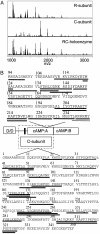Identification of the protein kinase A regulatory RIalpha-catalytic subunit interface by amide H/2H exchange and protein docking
- PMID: 14583592
- PMCID: PMC263775
- DOI: 10.1073/pnas.2232255100
Identification of the protein kinase A regulatory RIalpha-catalytic subunit interface by amide H/2H exchange and protein docking
Abstract
An important goal after structural genomics is to build up the structures of higher-order protein-protein complexes from structures of the individual subunits. Often structures of higher order complexes are difficult to obtain by crystallography. We have used an alternative approach in which the structures of the individual catalytic (C) subunit and RIalpha regulatory (R) subunit of PKA were first subjected to computational docking, and the top 100,000 solutions were subsequently filtered based on amide hydrogen/deuterium (H/2H) exchange interface protection data. The resulting set of filtered solutions forms an ensemble of structures in which, besides the inhibitor peptide binding site, a flat interface between the C-terminal lobe of the C-subunit and the A- and B-helices of RIalpha is uniquely identified. This holoenzyme structure satisfies all previous experimental data on the complex and allows prediction of new contacts between the two subunits.
Figures




References
-
- Gibson, R. M., Ji-Buechler, Y. & Taylor, S. S. (1997) J. Biol. Chem. 272, 16343-16350. - PubMed
-
- Huang, L. J. & Taylor, S. S. (1998) J. Biol. Chem. 273, 26739-26746. - PubMed
-
- Zheng, J., Knighton, D. R., Ten Eyck, L. F., Karlsson, R., Xuong, N., Taylor, S. S. & Sowadski, J. M. (1993) Biochemistry 32, 2154-2161. - PubMed
-
- Su, Y., Dostmann, W. R. G., Herberg, F. W., Durick, K., Xuong, N.-h., Ten Eyck, L. F., Taylor, S. S. & Varughese, K. I. (1995) Science 269, 807-819. - PubMed
-
- Ten Eyck, L. F., Mandell, J. G., Roberts, V. A. & Pique, M. E. (1995) in Proceedings of the 1995 ACM/IEEE Supercomputing Conference (IEEE Comput. Soc. Press, Los Alamitos, CA).
Publication types
MeSH terms
Substances
Associated data
- Actions
Grants and funding
LinkOut - more resources
Full Text Sources
Other Literature Sources

